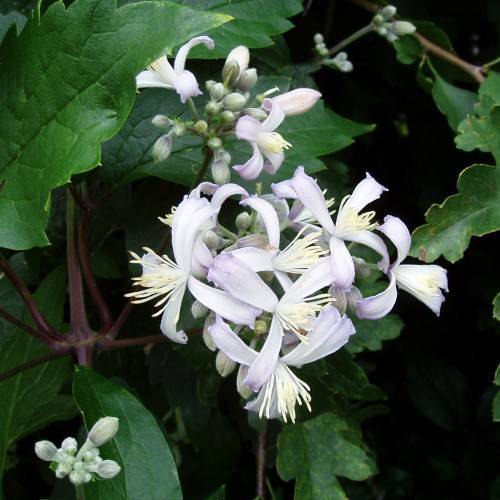
clematis
Clematis jouiniana
Cycle:
Perennial
Watering:
Average
Hardiness Zone:
4 - 8
Flowers:
Flowers
Sun:
Full sun,part shade
Leaf:
Yes
Growth Rate:
Low
Maintenance:
Low
Care Level:
Medium
watering
Watering your Clematis (Clematis jouiniana) can be as simple as 1, 2, 3. 1. Start by giving your plant a deep watering once a week. A deep drink of water will help your Clematis to establish a healthy and deep root system. 2. For the remainder of the week, your Clematis can receive shallow but frequent waterings. When the top few inches of soil are dry to the touch, it's time to water again. 3. Lastly, make sure to water your Clematis in the morning. This will give the plant plenty of time to absorb the moisture before the heat of the day. In general, avoid over-watering your Clematis. The soil should remain moist but never soggy. Water when the top of the soil feels dry and, if possible, avoid getting the foliage wet.
sunlight
Clematis jouiniana needs at least 5 hours of direct sunlight per day for optimal growth. Too little sunlight can result in poor flowering and leaf growth. When growing Clematis jouiniana, make sure that it is planted in an area that receives full sun in the morning until early afternoon and is then shaded for the remainder of the afternoon. This will ensure that it gets a good amount of sunlight without being exposed to intense heat for too long.
pruning
For Clematis jouiniana, pruning is best done in late winter or early spring. Prune lighty and remove any dead or diseased wood, then cut back the remaining stems to where the new growth will begin. Make sure to leave some foliage on the plant and remove no more than 1/3 of the total stem length overall. After an initial prune, maintain Clematis jouiniana by lightly pruning it again in the spring by removing any dead or crossing stems. Additionally, in areas with mild winters, you can lightly prune it again in the summer after flowering is finished. Pruning is very important for keeping this species healthy as it encourages new growth and helps to keep the plant from becoming overgrown.
Season
Hardiness Map
FAQ
Can Clematis plants grow in pots?
Yes, Clematis plants can definitely be grown in pots. When planting a Clematis in a pot make sure to use a larger size pot with drainage holes and fill it with a mix of well-draining potting soil and compost. Ensure to keep the root area cool and the pot in a sunny location while providing regular water and fertilization. Check the plant almost daily to make sure it is not becoming too dry. Clematis can do well in a pot and with the right care and conditions, they will thrive.
Are Clematis plants self-pollinating?
No, clematis plants are not self-pollinating. Clematis plants need pollinators such as bees, butterflies, moths and other insects to transfer pollen from the male anthers to the female stigma of the flower in order to produce viable seed. Pollination must also occur within relatively close proximity of the same species in order to create viable hybrid plants.
Can Clematis plants be grown as a houseplant?
Yes, Clematis plants can be grown as a houseplant. It is best to grow them in a pot with full sun and a soil that is rich in organic material and retains moisture. When potting the plant, place a stake or trellis next to the pot so that the vine can climb when it begins to grow. Be sure to water your Clematis plant regularly to keep it healthy and growing. Additionally, keep an eye out for pests and treat with natural insecticides as necessary.
Could Clematis plants survive in a colder climate?
Yes, Clematis plants can survive in colder climates with proper preparation. If planted in the fall, proper mulching should be done to protect the roots from cold temperatures. If planted in the spring, they should be watered frequently to help them adjust to the cooler temperatures more quickly. If temperatures drop below -20°C ( -4°F), additional measures may need to be taken such as the application of protective wraps and thermal insulation. Additionally, plants in exposed areas should be protected from the wind to prevent excessive dehydration. With the right measures in place, Clematis plants can easily survive in colder climates.
Could Clematis plants be grown in a greenhouse?
Yes, clematis plants can be grown in a greenhouse. Due to their vine-like growth habit and tropical native origins, clematis plants thrive in the moist and warm environment of a greenhouse. Clematis are generally grown from cuttings or from dividing existing plants, and benefit from regular pruning and fertilizing. They will also enjoy the indirect light of a greenhouse and the protection from strong winds and temperatures that the humidity and contained environment provides.
